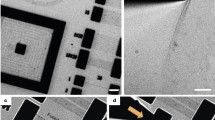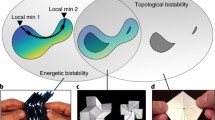Abstract
The extreme thinness of graphene combined with its tensile strength made it a material appealing for discussing and even making complex cut-kirigami or folded-only origami. In the case of origami, its stability is mainly defined by the positive energy of the single- or double-fold curvature deformation counterbalanced by the energy reduction due to favorable van der Waals contacts. These opposite sign contributions also have notably different scaling with the size L of the construction, the contacts contributing in proportion to area ~ L2, single folds as ~ L, and highly strained double-fold corners as only ~ L0 = const. Computational analysis with realistic atomistic-elastic representation of graphene allows one to quantify these energy contributions and to establish the length scale, where a single fold is favored (7 nm < L < 21 nm) or a double fold becomes sustainable (L > 21 nm), defining the size of the smallest possible complex origami designs as L ≫ 21 nm.
Impact statement
The flexibility and foldability of graphene are some of its attractive properties inspiring the designs of origami structures with potential use in flexible electronics and electromechanical nanodevices. The aesthetics, precision, and ease of folding and stability, however, have limitations at the nanoscale. Here, by means of large-scale atomistic calculations and continuum models, it is quantified how the dimensions determine the relative robustness of the elementary folds of graphene (a single fold and a double-folded graphene forming a single order-four vertex), thereby mapping the spatial resolution limits and providing important guidance for graphene nano-origami realizations.




Similar content being viewed by others
References
K.N. Kudin, G.E. Scuseria, B.I. Yakobson, C2F, BN, and C nanoshell elasticity from Ab Initio computations. Phys. Rev. B 64(23), 235406 (2001)
B.I. Yakobson, C.J. Brabec, J. Bernholc, Nanomechanics of carbon tubes: instabilities beyond linear response. Phys. Rev. Lett. 76(14), 2511 (1996)
B.I. Yakobson, R.E. Smalley, Fullerene nanotubes: C1,000,000 and beyond. Am. Sci. 85(4), 324 (1997)
T. Dumitrica, M. Hua, B.I. Yakobson, Symmetry-, time-, and temperature-dependent strength of carbon nanotubes. Proc. Natl. Acad. Sci. U.S.A. 103(16), 6105 (2006)
C. Lee, X. Wei, J.W. Kysar, J. Hone, Measurement of the elastic properties and intrinsic strength of monolayer graphene. Science 321(5887), 385 (2008)
F. Liu, P. Ming, J. Li, Ab Initio calculation of ideal strength and phonon instability of graphene under tension. Phys. Rev. B 76(6), 064120 (2007)
A. Fasolino, J.H. Los, M.I. Katsnelson, Intrinsic ripples in graphene. Nat. Mater. 6(11), 858 (2007)
E. Muñoz, A.K. Singh, M.A. Ribas, E.S. Penev, B.I. Yakobson, The ultimate diamond slab: GraphAne versus GraphEne. Diam. Rel. Mater. 19(5–6), 368 (2010)
B. Treml, A. Gillman, P. Buskohl, R. Vaia, Origami mechanologic. Proc. Natl. Acad. Sci. U.S.A. 115(27), 6916 (2018)
A.L. Vázquez de Parga, F. Calleja, B. Borca, M.C.G. Passeggi, J.J. Hinarejos, F. Guinea, R. Miranda, Periodically rippled graphene: growth and spatially resolved electronic structure. Phys. Rev. Lett. 100(5), 056807 (2008)
M.K. Blees, A.W. Barnard, P.A. Rose, S.P. Roberts, K.L. McGill, P.Y. Huang, A.R. Ruyack, J.W. Kevek, B. Kobrin, D.A. Muller, P.L. McEuen, Graphene Kirigami. Nature 524(7564), 204 (2015)
J.Y. Huang, F. Ding, B.I. Yakobson, P. Lu, L. Qi, J. Li, In situ observation of graphene sublimation and multi-layer edge reconstructions. Proc. Natl. Acad. Sci. U.S.A. 106(25), 10103 (2009)
A.K. Singh, E.S. Penev, B.I. Yakobson, Armchair or zigzag? A tool for characterizing graphene edge. Comput. Phys. Comm. 182, 804 (2011)
L.D. Landau, E.M. Lifshitz, Theory of Elasticity, 3rd ed.; Course of theoretical physics (Elsevier: Amsterdam, 1986, vol. 7).
S. Waitukaitis, R. Menaut, B.G. Chen, M. van Hecke, Origami multistability: from single vertices to metasheets. Phys. Rev. Lett. 114(5), 055503 (2015)
T. Hull, On the mathematics of flat origamis. Congressus Numerantium 100, 215 (1994)
M. Bern, B. Hayes, The Complexity of Flat Origami, Proceedings of the Seventh Annual ACM-SIAM Symposium on Discrete Algorithms, SODA 96, 175 (1996).
M. Arroyo, T. Belytschko, Finite crystal elasticity of carbon nanotubes based on the exponential Cauchy-Born Rule. Phys. Rev. B 69(11), 115415 (2004)
J. Tersoff, Energies of fullerenes. Phys. Rev. B 46(23), 15546 (1992)
Z. Tu, Z. Ou-Yang, Single-walled and multiwalled carbon nanotubes viewed as elastic tubes with the effective Young’s moduli dependent on layer number. Phys. Rev. B 65(23), 233407 (2002)
I.V. Lebedeva, A.S. Minkin, A.M. Popov, A.A. Knizhnik, Elastic constants of graphene: comparison of empirical potentials and DFT calculations. Physica E 108, 326 (2019)
Z. Xu, M.J. Buehler, Geometry controls conformation of graphene sheets: membranes, ribbons, and scrolls. ACS Nano 4(7), 3869 (2010)
B. Sajadi, S. van Hemert, B. Arash, P. Belardinelli, P.G. Steeneken, F. Alijani, Size- and temperature-dependent bending rigidity of graphene using modal analysis. Carbon 139, 334 (2018)
H. Chen, X.-L. Zhang, Y.-Y. Zhang, D. Wang, D.-L. Bao, Y. Que, W. Xiao, S. Du, M. Ouyang, S.T. Pantelides, H.-J. Gao, Atomically precise, custom-design origami graphene nanostructures. Science 365(6457), 1036 (2019)
O.-K. Park, C.S. Tiwary, Y. Yang, S. Bhowmick, S. Vinod, Q. Zhang, V.L. Colvin, S.A. Syed Asif, R. Vajtai, E.S. Penev, B.I. Yakobson, P.M. Ajayan, Magnetic field controlled graphene oxide-based origami with enhanced surface area and mechanical properties. Nanoscale 9 (21), 6991 (2017).
Y. Wang, S. Wang, P. Li, S. Rajendran, Z. Xu, S. Liu, F. Guo, Y. He, Z. Li, Z. Xu, C. Gao, Conformational phase map of two-dimensional macromolecular graphene oxide in solution. Matter 3(1), 230 (2020)
S. Plimpton, Fast parallel algorithms for short-range molecular dynamics. J. Comput. Phys. 117(1), 1 (1995)
S.J. Stuart, A.B. Tutein, J.A.A. Harrison, A reactive potential for hydrocarbons with intermolecular interactions. J. Chem. Phys. 112(14), 6472 (2000)
Q. Lu, M. Arroyo, R. Huang, Elastic bending modulus of monolayer graphene. J. Phys. D 42(10), 102002 (2009)
Acknowledgments
This work was supported by the US Department of Defense: Air Force Office of Scientific Research (AFOSR), Grant #FA9550-17-1-0262. Z.Z. and Z.H. at NUAA were supported by the Research Fund of State Key Laboratory of Mechanics and Control of Mechanical Structures (No. MCMS-E-0420K01). Computer resources were provided by XSEDE, which is supported by National Science Foundation (NSF) Grant #OCI-1053575, under allocation TG-DMR100029, and the NOTS cluster at Rice University acquired with funds from NSF Grant #CNS-1338099.
Author information
Authors and Affiliations
Corresponding author
Rights and permissions
About this article
Cite this article
Yang, Y., Zhang, Z., Hu, Z. et al. Energetics of graphene origami and their “spatial resolution”. MRS Bulletin 46, 481–486 (2021). https://doi.org/10.1557/s43577-020-00018-8
Received:
Accepted:
Published:
Issue Date:
DOI: https://doi.org/10.1557/s43577-020-00018-8




